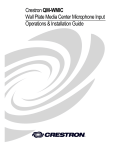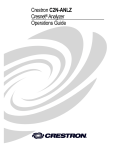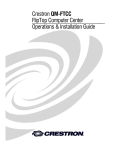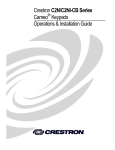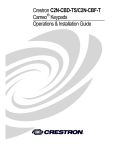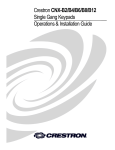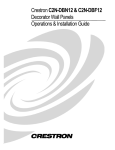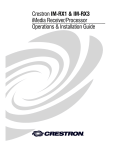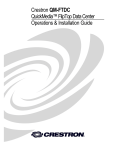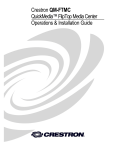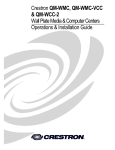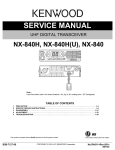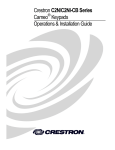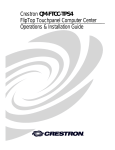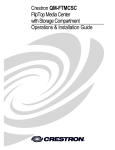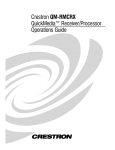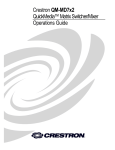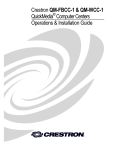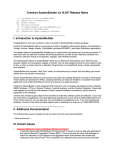Download Crestron QM-FTSC Installation guide
Transcript
Crestron QM-FTSC FlipTop Storage Center Operations & Installation Guide This document was prepared and written by the Technical Documentation department at: Crestron Electronics, Inc. 15 Volvo Drive Rockleigh, NJ 07647 1-888-CRESTRON All brand names, product names and trademarks are the property of their respective owners. ©2004 Crestron Electronics, Inc. Crestron QM-FTSC FlipTop Storage Center Contents FlipTop Storage Center: QM-FTSC 1 Introduction ..........................................................................................................1 Features and Functions...........................................................................1 The QuickMedia Transport System .......................................................2 Specifications .........................................................................................4 Physical Description...............................................................................5 Industry Compliance ............................................................................10 Setup...................................................................................................................11 Network Wiring ...................................................................................11 Identity Code........................................................................................12 Installation............................................................................................15 Hardware Hookup ................................................................................18 Ground Wire Connections....................................................................20 Configuration Software ......................................................................................20 Earliest Version Software Requirements for the PC ............................21 Configuring with Crestron SystemBuilder...........................................21 Configuring with SIMPL Windows .....................................................24 Programming with VisionTools Pro-e .................................................31 Example Program.................................................................................31 Adjusting the QM-FTSC Microphone Inputs.......................................31 Uploading and Upgrading ..................................................................................34 Communication Settings ......................................................................34 Uploading a SIMPL Windows Program ..............................................37 Firmware Upgrade ...............................................................................38 Problem Solving .................................................................................................41 Further Inquiries...................................................................................43 Future Updates .....................................................................................43 Return and Warranty Policies.............................................................................44 Merchandise Returns / Repair Service .................................................44 CRESTRON Limited Warranty ...........................................................44 Operations & Installation Guide – DOC. 6269 Contents • i Crestron QM-FTSC FlipTop Storage Center FlipTop Storage Center: QM-FTSC Introduction Features and Functions The QM-FTSC-B and the QM-FTSC-BALUM are part of the Crestron MediaManager™ line of network devices, room control systems and signal routing solutions. The suffix ‘-B’, and ‘-BALUM’, respectively denotes color, e.g., QM-FTSC-B is a black unit, and QM-FTSC-BALUM has a brushed aluminum finish. For simplicity within this guide, color suffix is omitted and the designation QM-FTSC is used except where noted. This Cresnet device uses QuickMedia™ technology to facilitate an uncomplicated connection of audio, video, and computer equipment. All media and control signals are routed via a single QuickMedia cable for simple installation. A complete integrated room solution is created with the addition of a QuickMedia receiver (such as the QM-RMCRX) and optional keypads or touchpanels. Functional Summary • Built-in six button engravable* keypad with LEDs • All A/V connections are on the underside, includes cables that feed through the box (includes QM-FTCMK cable plate kit) • 3 X 1 video switch with sync sensing and LED indicators (one composite connector, one S-video connector, one RGBHV connector) • 3 X 1 audio switch (two stereo RCA, one stereo 1/8” mini jack) with audio breakaway • One AC power passthrough • One RGB monitor passthrough • Two Neutrik™ combo inputs with phantom power • One QuickMedia RJ-45 connector (on the right side) • Two Cresnet connectors (on the right side) * As an option, custom-engraved buttons can be designed and obtained by using the Crestron Engraver software. Version 2.1.03 and Crestron Database 16.2.0 or later are available from the Downloads | Software Updates section of the Crestron website (www.crestron.com). Operations & Installation Guide – DOC. 6269 FlipTop Storage Center: QM-FTSC • 1 FlipTop Storage Center Crestron QM-FTSC NOTE: The QM-FTSC is compatible with 2-Series control systems only. QM-FTSCD Block Diagram Cables Composite Video S-Video Computer RGB Composite Video Audio S-Video Audio Computer Audio AC Power Keypad MIC 1 MIC 2 Program L Program R Video 3 X 1 Video Switch A/D Converter A/D Converter QM Output Cresnet Cresnet 3 X 1 Audio Switch Input Gain Video Sync Sensing AC Power RGB Monitor Composite Video S-Video Computer RGB Composite Video Audio S-Video Audio Computer Audio Microphone 2 Phantom Power Microphone 1 Buffer The QuickMedia Transport System Using a new, proprietary signal routing solution, signals such as composite video, S-video, RGBHV, audios, and microphone, are all transported using a single cable solution called QuickMedia™ (QM). The QM transport system port is capable of managing computer, video, and audio signals simultaneously through one CAT5E/UTP1 wire, simplifying installations. Routing CAT5E/UTP1 cable is less expensive and much simpler than routing multi-colored, multi-conductor coax cable. All Crestron products using the QM transport system are capable of sending and receiving QM signals via standard CAT5E unshielded twisted pair (UTP) cable. Crestron recommends Belden Media-Twist cable, and Liberty Cable Crescat-QM. Installation of any QM device is as simple as installing one set of QM wires from output to input. Installations are flexible, affordable, and fast. 2 • FlipTop Storage Center: QM-FTSC Operations & Installation Guide - DOC. 6269 Crestron QM-FTSC FlipTop Storage Center The Crescat-QM cable contains one CAT5E cable and one Cresnet® cable in a siamese jacket. If you choose to use Belden MediaTwist or other CAT5E for the AV signals, then you need to install a separate Cresnet cable for control and power. QuickMedia Cable – CRESCAT-QM The pin assignment is based on the EIA/TIA 568B RJ-45 Jack standard. To determine which pin is number 1, hold the cable so that the end of the eight pin modular jack is facing you, with clip down and copper side up. When looking down at the copper connections, pin 1 is on the far right. QuickMedia Pin and Pair Assignment RJ-45 Male Connector RJ-45 Pin Number CAT5E Pair Number Wire Colors QM Assignment RGB and Audio QM Assignment Composite, S-video and Audio 1 2 White/Orange - RGB Red - Chrominance 2 2 Orange + RGB Red + Chrominance 3 3 White/Green - RGB Green - Luminance 4 1 Blue + Audio + Audio 5 1 White/Blue - Audio - Audio 6 3 Green + RGB Green + Luminance 7 4 White/Brown - RGB Blue - Composite 8 4 Brown + RGB Blue + Composite The total accumulated skew from QM transmitter to QM receiver must not exceed 15 ns (nanoseconds). Crestron recommends a cable with a rating of less than or equal to 15 ns over its entire length. For example, if using a cable with a rating of 15 ns/100 meters (100 meters = 328 feet), connecting the QMWMC/QM-WMIC QM transmitter with 150 feet of cable to a QM-MD7x2 switcher, and then using another 150 feet to connect the QM-RMCRX receiver, the accumulated skew over the entire 300 feet should not exceed 15 ns. Operations & Installation Guide – DOC. 6269 FlipTop Storage Center: QM-FTSC • 3 FlipTop Storage Center Crestron QM-FTSC Specifications Specifications for the QM-FTSC are given in the following table. QM-FTSC Specifications SPECIFICATION DETAILS Power Requirements 8 Watts (0.33 Amp @ 24 VDC) Default Network IDs 04 (QM-WMC/QM-WMIC) 73 (C2N-DB6) Video Formats Composite, S-video, RGBHV Video Detection Within 2 seconds Firmware QM-WMC.V.2.24.upg or later PK_C2NDB6.V1.00a.csf or later 2-Series Control System Update Files1,2 Version 3.093.CUZ or later Connectors Computer Input (1) DB15HD female, video sensing on H-sync Computer Output (1) DB15HD female for monitor out Computer Audio (1) 3.5mm mini-jack, computer soundcard type Composite Video (1) RCA (yellow), video sensing Composite Video Audio (2) RCA (red and white) S-video (1) Mini-DIN 4-pin, video sense on luminance signal S-video Audio (2) RCA (red and white) QuickMedia Output (1) RJ-45 CAT5 Cresnet (2) 4-pin terminal block Ground (1) Ground Terminal Microphone (2) Neutrik Combo: XLR & ¼” phone per input Video Types Composite, S-video, and RGB Video Sensing Automatic sensing of composite, S-video (luminance), and RGB (H-Sync) with corresponding LED indicators Gain 0 dB (unity gain, 75 Ohm termination) Maximum Input Voltage 1.0 V p-p Input Impedance 75 ohms Bandwidth (Composite & S-video) > 100 MHz (-3 dB) at unity gain Max Resolution/Refresh Rate (RGB) 1600 x 1200 @ 60 Hz vertical rate with CAT5/5E/6 cable length of 100 meters and skew rating ≤ 15 ns / 100 meters3 H and V Sync (RGB) 5.0 V p-p max into 1 KΩ Specifications continued on next page. 4 • FlipTop Storage Center: QM-FTSC Operations & Installation Guide - DOC. 6269 Crestron QM-FTSC FlipTop Storage Center QM-FTSC Specifications (continued) SPECIFICATION DETAILS Audio Analog-Digital Conversion 24 bit / 48 kHz Maximum line-level input 2 Vrms/ 6 dBVrms (Video) 1 Vrms/ 0 dBVrms (PC) Input Impedance 10k ohms Bandwidth 20 Hz to 20 kHz Operating Temperature and Humidity 41º to 104º F (5º to 40º C) 10 to 90% relative humidity (non-condensing) Dimensions and Weight Width: 8.26 in (20.98 cm) Height: 6.08 in (15.44 cm) Depth: 6.23 in (15.82 cm) Weight: 8.8 lbs (3.99 kg) with cables 1. The latest software versions can be obtained from the Downloads | Software Updates section of the Crestron website (www.crestron.com). Refer to the NOTE following these footnotes. 2. Crestron 2-Series control systems include the AV2 and PRO2. Consult the latest Crestron Product Catalog for a complete list of 2-Series control systems. 3. Longer lengths of CAT5/5E/6 cable can be used. However, the cumulative skew must be ≤ 15 ns for the entire length of cable used between all QM devices. Longer lengths of cable may experience eventual loss of bandwidth when viewing higher resolution sources. For more information, refer to page 3. NOTE: Crestron software and any files on the website are for Authorized Crestron dealers and Crestron Authorized Independent Programmers (CAIP) only. New users may be required to register to obtain access to certain areas of the site (including the FTP site). Physical Description Refer to the physical views shown below. Top View Bottom View Operations & Installation Guide – DOC. 6269 FlipTop Storage Center: QM-FTSC • 5 FlipTop Storage Center Crestron QM-FTSC Physical Dimensions - Top View Bottom View 8.26 in (20.98 cm) 6.23 in (15.82 cm) Back View Right Side View 7.76 in (19.71 cm) 6.08 in (15.44 cm) 5.12 in (13.00 cm) 5.19 in (13.19 cm) 6 • FlipTop Storage Center: QM-FTSC Operations & Installation Guide - DOC. 6269 Crestron QM-FTSC FlipTop Storage Center Controls and Ports (Top) Buttons 2 4 6 1 3 5 The QM-FTSC has six buttons. All buttons are functionally identical and have light emitting diodes (LEDs) that serve as user feedback indicators. The illumination of each LED (on/off) is independently addressable, and programmable using SIMPL Windows. In the program, the intensity level for all button LEDs can be set from 0 to 100%. NOTE: Numbers are for programming purposes only. For programming purposes the buttons are arranged numerically from bottom to top, left to right. NOTE: These button units do not support audio WAV files. AC Outlet 125V – 50/60Hz 10A The AC outlet is rated at 125 VAC @ 10 Amps, 50 – 60 Hz. Ports and Indicators (Underside) VIDEO R The yellow RCA connector is used for connecting a composite video source to the presentation system. A corresponding set of stereo RCA audio inputs (red and white) are provided for the video source’s audio program. This port can automatically detect the presence of a composite video signal. An LED indicates the presence of a composite video signal. L S-VIDEO 2 This 4-pin DIN-type connector is used for connecting an S-video source to the presentation system. A corresponding set of stereo RCA audio inputs (red and white) are provided for the video source’s audio program. This port can automatically detect the presence of a luminance video signal on pin 3. An LED indicates the presence of a luminance signal. Refer to the following table for pin assignments. 4 S-VIDEO 3 1 S-Video Pin Assignments AUDIO R L PIN DESCRIPTION 1 Ground 2 Ground 3 Luminance 4 Chrominance Operations & Installation Guide – DOC. 6269 FlipTop Storage Center: QM-FTSC • 7 FlipTop Storage Center Crestron QM-FTSC COMPUTER This female connector is used for connecting a computer’s RGB video output to the presentation system. A corresponding 3.5mm mini-jack is provided for the computer sound card output. This port can automatically detect the presence of an H-sync video signal on pin 15. An LED near the RGB connector indicates the presence of an H-sync signal. Refer to the following table for pinassignments. AUDIO C O M P U T E R Pin 6 Pin 1 Pin 5 Pin 15 RGB DB15HD Pin Assignments PIN FUNCTION PIN FUNCTION 1 Red Video 9 No Connect 2 Green Video 10 Ground 3 Blue Video 11 No Connect 4 Reserved 12 Monitor Sense 1 5 Ground 13 Horizontal Sync 6 Red Ground 14 Vertical Sync 7 Green Ground 15 Monitor Sense 2 8 Blue Ground MONITOR Pin 6 M O N I T O R Pin 1 Pin 5 Pin 15 This female connector is a buffered pass-through port for connecting a secondary computer display to the computer’s RGB video output. Refer to the following table for pin assignments. RGB DB15HD Pin Assignments PIN FUNCTION PIN FUNCTION 1 Red Video 9 No Connect 2 Green Video 10 Ground 3 Blue Video 11 No Connect 4 Reserved 12 No Connect 5 Ground 13 Horizontal Sync 6 Red Ground 14 Vertical Sync 7 Green Ground 15 No Connect 8 Blue Ground MIC 1 / MIC 2 PUSH NEUTRIK Each MIC port is a Neutrik Combo connector that contains an XLR connector for use with balanced condenser or dynamic microphones. The XLR connectors feature switchable phantom power. The ¼” phone connector is for use with devices that provide line-level signals such as wireless microphone receivers or the output of a microphone mixer. 8 • FlipTop Storage Center: QM-FTSC Operations & Installation Guide - DOC. 6269 Crestron QM-FTSC FlipTop Storage Center NET (x2) NET 24 Y Z G NET 24 Y Z G These two 4-pin terminal block connectors, located on the right side of the QMFTSC, are for connection to the Cresnet network. One connector is used to connect to the Cresnet network while the second connector can be used to connect another Cresnet device. Cresnet power to the QM-FTSC is supplied through either of these connectors. For more information, refer to “Network Wiring” on page 11. QM This eight-pin RJ-45 transport port, located on the right side of the QM-FTSC, allows connection of the QuickMedia cable. It carries audio, video, and microphone signals over CAT5E cable to a QuickMedia receiver or switcher. For more information on QuickMedia refer to page 2. 1 8 QM Pin Assignments PIN WIRE COLORS (568B) DESCRIPTION 1 WHITE/ORANGE - RGB Red 2 ORANGE + RGB Red 3 WHITE/GREEN - RGB Green 4 BLUE + Digital Audio 5 WHITE/BLUE - Digital Audio 6 GREEN + RGB Green 7 WHITE/BROWN - RGB Blue 8 BROWN + RGB Blue NOTE: When transmitting S-video, luminance uses the green video pathway, and chrominance uses the red video pathway. When transmitting composite video, the signal is carried on the blue video pathway. NOTE: Always use Crescat-QM cable, or a good quality CAT5E/CAT6 cable to make QuickMedia connections. NOTE: When using Crescat-QM Siamese cable, four additional wires are included for making Cresnet connections. AC Power Connect the six-foot (183 cm) grounded AC line cord to supply AC power to the outlet on the topside of the QM-FTSC. 125V – 50/60Hz 10A Operations & Installation Guide – DOC. 6269 FlipTop Storage Center: QM-FTSC • 9 FlipTop Storage Center Crestron QM-FTSC Indicators PWR (Power) This LED illuminates when 24 volts DC is supplied to the QM-FTSC from Cresnet. NET This LED illuminates when communication between the control system and the QM-FTSC is established (the unit is polled on the network). Illumination indicates that the SIMPL Windows program currently loaded has a network device defined at the same Net ID as the QM-FTSC. The LED flashes when communication with the processor occurs. COMP The COMP LED illuminates when an RGB signal from the computer port is detected. VIDEO This LED illuminates when the presence of a composite video signal is detected by the QM-FTSC. S-VID This LED illuminates when the presence of an S-video signal is detected by the QM-FTSC. MIC PWR Illuminates when phantom power is applied to the microphone inputs. SETUP LED and Pushbutton The QM-FTSC is Touch-Settable ID-ready. A SETUP pushbutton is concealed behind a faceplate during normal use. The SETUP pushbutton and its associated LED are used for setting a units network ID during the initial configuration of a Cresnet system or when the device is being added/replaced. Refer to “Method B (Touch Settable ID)” on page 13 for detailed information. Industry Compliance As of the date of manufacture, the QM-FTSC has been tested and found to comply with specifications for CE marking and standards per EMC and Radiocommunications Compliance Labelling (N11785). NOTE: This device complies with part 15 of the FCC rules. Operation is subject to the following two conditions: (1) this device may not cause harmful interference, and (2) this device must accept any interference received, including interference that may cause undesired operation. 10 • FlipTop Storage Center: QM-FTSC Operations & Installation Guide - DOC. 6269 Crestron QM-FTSC FlipTop Storage Center Setup Network Wiring CAUTION: Provide sufficient power to the system. Insufficient power can lead to unpredictable results or damage to the equipment. Please use the Crestron Power Calculator to help calculate how much power is needed for the system. <http://www.crestron.com/dealer-tech_resources/power_calculator.asp> CAUTION: Use only Crestron power supplies for Crestron equipment. Failure to do so could cause equipment damage or void the Crestron warranty. NOTE: When installing network wiring, refer to the latest revision of the wiring diagram(s) appropriate for your specific system configuration, available from the Downloads | Product Manuals | Wiring Diagrams section of the Crestron website (www.crestron.com). When calculating the wire gauge for a particular Cresnet run, the length of the run and the power factor of each network unit to be connected must be taken into consideration. If Cresnet units are to be daisy-chained on the run, the power factor of each unit to be daisy-chained must be added together to determine the power factor of the entire chain. If the unit is a home-run from a Crestron system power supply network port, the power factor of that unit is the power factor of the entire run. The length of the run in feet and the power factor of the run should be used in the resistance equation below to calculate the value on the right side of the equation. Resistance Equation R < 40,000 L x PF Where: R = Resistance (refer to table below). L = Length of run (or chain) in feet. PF = Power factor of entire run (or chain). The required wire gauge should be chosen such that the resistance value is less than the value calculated in the resistance equation. Refer to the table on the next page. Wire Gauge Values RESISTANCE 4 WIRE GAUGE 16 6 18 10 20 15 22 13 Doubled CAT5 8.7 Tripled CAT5 NOTE: All Cresnet wiring must consist of two twisted pairs. One twisted pair is the +24V conductor and the GND conductor, and the other twisted pair is the Y conductor and the Z conductor. NOTE: When daisy-chaining Cresnet units, strip the ends of the wires carefully to avoid nicking the conductors. Twist together the ends of the wires that share a pin on the network connector, and tin the twisted connection. Apply solder only to the ends of the twisted wires. Avoid tinning too far up the wires or the end Operations & Installation Guide – DOC. 6269 FlipTop Storage Center: QM-FTSC • 11 FlipTop Storage Center Crestron QM-FTSC becomes brittle. Insert the tinned connection into the Cresnet connector and tighten the retaining screw. Repeat the procedure for the other three conductors. NOTE: For additional information on video connections over CAT5, refer to the latest version of the Crestron CAT5 Wiring Reference Guide (Doc. 6137) which is available from the Downloads | Product Manuals section of the Crestron website (www.crerstron.com). NOTE: For larger networks (i.e., greater than 28 network devices), it may be necessary to add a Cresnet Hub/Repeater (CNXHUB) to maintain signal quality throughout the network. Also, for networks with lengthy cable runs or varying types of network devices, it may be desirable to add a hub/repeater after only 20 network devices. Identity Code Every equipment and user interface within the network requires a unique identity code (Net ID). These codes are two-digit hexadecimal numbers from 03 to FE. The Net ID of each unit must match an ID code specified in the SIMPL Windows program. Refer to “Setting the Net ID in Device Settings” on page 26 for details of the SIMPL Windows procedure. Refer to the note on page 34 for a definition of Viewport. The Net ID of the QM-FTSC has been factory set to 04 for the input/output section, and 73 for the keyboard section. The Net IDs of multiple QM-FTSCs in the same system must be unique. Net IDs are changed from a personal computer (PC) via the Crestron Viewport. NOTE: For detailed information on establishing communication between the PC and control system, refer to “Communication Settings” on page 34. If communication cannot be established, refer to the “Troubleshooting Communications” section in the respective Operations Guide for the control system. There are two different methods—Method A or Method B—for setting the Net ID: Method A (Cresnet address-settable ID), described as follows, applies to devices in a Cresnet system with a 2-Series control system and requires that a single unit be the only network device connected to the control system. Method B (Touch Settable ID or TSID), which begins on page 13, applies to all TSID-ready devices in a Cresnet system with 2-Series control system upgrade file (CUZ) version 3.029 or later. TSID functionality makes it possible for the control system to recognize a network device via its serial number, which is stored in the device’s memory. This method does not require that any devices be disconnected from the network; Net IDs may be set with the entire Cresnet system intact. This method requires the use of the Crestron Viewport version 3.35 or later. Use the appropriate method to set the Net ID. Method A (Cresnet address-settable ID) 1. Ensure that the device requiring a Net ID change is the only unit connected to the control system. 2. Open the Crestron Viewport. 12 • FlipTop Storage Center: QM-FTSC Operations & Installation Guide - DOC. 6269 Crestron QM-FTSC FlipTop Storage Center 3. From the Viewport menu, select Functions | Set Network ID. The software checks the baud rate and then opens the "Set Network ID" window. 4. In the "Set Network ID" window, select the device requiring a Net ID change from the Current Network Devices text window. 5. Select the new Net ID for the device from the Choose the new network ID for the selected device (Hex): text box. 6. Click Set ID to initiate the change. This will display the "ID command has been sent" window. 7. In the "Command Complete" window, click OK. 8. In the Current Network Devices text window, verify the new Net ID code. 9. In the "Set Network ID" window, click Close. NOTE: The new Net ID code may also be verified by selecting Diagnostic | Report Network Devices in the Viewport (alternately, select F4). 10. Repeat this procedure for each additional network device requiring a Net ID change. Method B (Touch Settable ID) Before using this method, you should have a list of all current network devices and their Net IDs, to avoid assigning duplicate IDs. Set Net ID by TSID These procedures are for TSID-enabled network devices during the initial configuration of a Cresnet system or when such devices are being added/replaced. 1. Ensure that all network devices are connected to the control system. 2. Open the Crestron Viewport version 3.35 or later. 3. From the Viewport menu, select Functions | Assign Cresnet ID by Serial Number. The “Set Net ID by TSID” window appears. The window is first displayed with the data fields empty. 4. Click on the Search for Touch Settable Devices button. The system searches the network and lists all TSID-enabled devices found. The list is similar to the report produced by pressing F4 (Report Network Devices); the first eight digits of each line constitute the TSID number (hexadecimal form of the serial number). Operations & Installation Guide – DOC. 6269 FlipTop Storage Center: QM-FTSC • 13 FlipTop Storage Center Crestron QM-FTSC “Set Net ID by TSID” Window 5. Enter either the serial number or TSID number of the device that requires a change. The list scrolls to and highlights the device listing. The listing should show the device’s default Cresnet ID (a.k.a. Net ID). 6. Enter the Cresnet ID that the device should be set to and click OK. The number you enter should appear on the list. CAUTION: This function does not prevent you from setting duplicate IDs. Be sure to check current assignments before entering the desired Cresnet ID number. Serial Number to TSID Conversion This utility is useful in a case where there are multiple devices of the same type on a network, you need to locate a particular one, you know the TSID but not the serial number, and your site installation list is based on device serial numbers. In this (or the reverse) situation, do the following: 1. Open the Crestron Viewport. 2. From the Viewport menu, select Functions | Serial Number ÅÆ TSID Conversion Tool. The “Serial Number ÅÆTSID Conversion Tool” window is displayed. “Serial Number to TSID Conversion Tool” Window 14 • FlipTop Storage Center: QM-FTSC Operations & Installation Guide - DOC. 6269 Crestron QM-FTSC FlipTop Storage Center 3. Enter the serial number or TSID number as instructed; press the appropriate button to obtain the corresponding number. NOTE: Enter serial numbers, including spaces, exactly as they appear on the unit label. Alpha characters in serial numbers or TSID numbers may be entered in upper or lower case. Installation Supplied Parts Part Quantity Small Cable Bushing, 5/16 inch ID, 0.5 inch OD 8 Large cable Bushing, 0.55 inch ID, 0.80 inch OD 1 Cable Support Plate 1 LG Black screw #4 x 3/16, Pan Head, Phillips 4 Screw #6-32, Pan Head, Phillips 8 Screw #10, Pan Head, Phillips 4 Mounting Bracket 2 Tie Wrap 9 Composite Video Cable, RCA to RCA, 6 ft long, with “VIDEO” Label 1 Audio Cable, RCA to RCA, 6 ft long, with “AUDIO-L” label 2 Audio Cable, RCA to RCA, 6 ft long, with “AUDIO-R” label 2 S-Video Cable, 6 ft long 1 Computer RGB Cable, VGA to VGA, 6 ft long 1 Computer Audio Cable, 3.5 mm Stereo, 6 ft long 1 Tools Required • Phillips screwdriver • Small flat-blade screwdriver (for connecting the VGA cable) Cable Support Plate The cable support plate must be installed first. 1. Place the bushings on the cables (nine bushings supplied). Use the large bushing for the VGA cable. 2. Thread the cables through the appropriate slot on the plate. 3. Snap the bushings into the plate slots. 4. Feed all the excess cable through the opening. 5. Attach the plate using the four #4 x 3/16 LG black screws supplied. 6. Connect the cables to the bottom of the QM-FTSC. 7. Secure the cables to the bottom bar using the tie wraps (nine tie wraps are supplied). Operations & Installation Guide – DOC. 6269 FlipTop Storage Center: QM-FTSC • 15 FlipTop Storage Center Crestron QM-FTSC Cable Plate Installation Cable Support Plate Bushing (4) #4 x 3/16 LG Black Screws Cable Tie Wrap Location Connected Cable End Bar Tie Wrap Cable Passed Through Cable Support Plate Excess Cable Loop 16 • FlipTop Storage Center: QM-FTSC Operations & Installation Guide - DOC. 6269 Crestron QM-FTSC FlipTop Storage Center Mounting to Surface The QM-FTSC is designed to mount in a horizontal surface, such as a desk top, lectern, or podium. The following diagram illustrates the required opening size to accommodate the QM-FTSC. Mounting Hole Dimensions 7.88 in (20.00 cm) 5.88 in (14.92 cm) Radius 0.125 in (0.318 cm) NOTE: Before inserting the QM-FTSC in the mounting hole, ensure that all required cables have been installed. 1. Install the eight supplied #6-32 screws, but do not tighten (four on the front side and four on the rear side). These will be used to secure the front and rear mounting brackets. 2. Position the QM-FTSC in the mounting hole. Mounting Bracket Screw Locations NOTE Connectors on right side. Use care when mounting through opening. #6-32 Screws #6-32 Screws Surface Cutout Operations & Installation Guide – DOC. 6269 FlipTop Storage Center: QM-FTSC • 17 FlipTop Storage Center Crestron QM-FTSC 3. Install the four #10 screws in the mounting brackets (two screws per bracket). Refer to the following diagram. 4. Slide the mounting brackets over the #6-32 screws and tighten the #632 screws. 5. Turn the four #10 screws equally until they contact the underside of the mounting surface. NOTE: Do not over-tighten the #10 screws as this may damage the surface and/or the unit. Mounting Bracket Installation Mounting Surface Mounting Bracket #10 Screws Mounting Bracket #10 Screws Hardware Hookup Refer to the following hookup diagram and, aside from attaching power last, complete the connections in any order. NOTE: To prevent overheating, do not operate this product in an area that exceeds the environmental temperature range listed in the specifications table. Consideration must be given if installed in a closed or multi-unit rack assembly, inside a closed desk, or in a closed podium since the operating ambient temperature of these environments may be greater than the room ambient. Contact with thermal insulating materials should be avoided on all sides of the unit. 18 • FlipTop Storage Center: QM-FTSC Operations & Installation Guide - DOC. 6269 Crestron QM-FTSC FlipTop Storage Center NOTE: The maximum continuous current from equipment under any external load conditions shall not exceed a current limit that is suitable for the minimum wire gauge used in interconnecting cables. The ratings on the connecting unit's supply input should be considered to prevent overloading the wiring. Underside Connections STEREO AUDIO INPUT: (PAIR WITH S-VIDEO INPUT) VIDEO INPUT: FROM S-VIDEO SOURCE COMPUTER AUDIO INPUT: FROM PC SOUND CARD (PAIR WITH COMPUTER INPUT) COMPUTER LOOP-THROUGH: TO COMPUTER MONITOR (IF USED) 120 VAC Line Cord MIC INPUTS: CONNECT TO TWO BALANCED CONDENSER OR DYNAMIC MICROPHONES OR BALANCED/ UNBALANCED LINE LEVEL SOURCES STEREO AUDIO INPUT: (PAIR WITH COMPOSITE VIDEO INPUT) VIDEO INPUT: FROM COMPOSITE VIDEO SOURCE Ground COMPUTER INPUT: FROM PC RGB VIDEO OUTPUT Right Side Connections QM OUTPUT: QUICKMEDIA PORT CARRIES AUDIO, VIDEO, RGB, AND MICROPHONE SIGNALS TO QUICKMEDIA RECEIVER CRESNET: TO CONTROL SYSTEM AND OTHER CRESNET DEVICES Operations & Installation Guide – DOC. 6269 FlipTop Storage Center: QM-FTSC • 19 FlipTop Storage Center Crestron QM-FTSC Ground Wire Connections Proper grounding is required. Connect the ground from the QM transmitter (QM-FTSC) to earth ground. Connect the Cresnet shield at the QM-RMCRX to the chassis ground provided on the QM-RMCRX. The QM-RMCRX chassis must also be connected to an earth ground (building steel). Refer to the following grounding diagram. Ground Wire Connections QM-RMCRX Ground Wire to Earth Ground 24 Y Z G QM-FTSC Shield Cresnet Ground Wire Ground terminal to Earth Ground NOTE: Do not connect the shield to earth ground at the QM-FTSC Configuration Software Have a question or comment about Crestron software? Answers to frequently asked questions (FAQs) can be viewed in the Online Help section of the Crestron website (www.crestron.com). To post a question or view questions you have submitted to Crestron’s True Blue Support, log in at http://support.crestron.com. First-time users will need to establish a user account. Configuration is easy thanks to Crestron’s Windows-based programming software. Crestron SystemBuilder™ software creates a complete project, with no special programming required. SystemBuilder completes all necessary programming for a base system including all touchpanel screens and the control system program. The program output of SystemBuilder is a SIMPL Windows program with much of the functionality encapsulated in macros and templates. Once SystemBuilder creates the project, the system interfaces and program logic can be customized in SystemBuilder or can be easily modified with Crestron development tools (i.e., SIMPL Windows and Crestron VisionTools® Pro-e (VT Pro-e) software packages). SystemBuilder comes with templates for all supported interfaces. If a user wishes to create a touchpanel project using templates with a different look-andfeel, this can be accomplished by making a custom template. This custom template can then be used by SystemBuilder to create the final project files to be loaded into the panels. Alternatively, VT Pro-e can be used to tweak projects created with the SystemBuilder or develop original touchpanel screen designs. Once the program created by SystemBuilder is loaded into the control system, Digital Media Tools (DMT) Software can be used to tune the system for optimal performance. DMT software can be used to test the quality of audio and video signals as well as fine-tune audio and video settings. 20 • FlipTop Storage Center: QM-FTSC Operations & Installation Guide - DOC. 6269 Crestron QM-FTSC FlipTop Storage Center Earliest Version Software Requirements for the PC NOTE: Crestron recommends the use of SystemBuilder and Digital Media Tools software for creating and fine-tuning a QuickMedia system. NOTE: Crestron recommends that you use the latest software to take advantage of the most recently released features. The latest software is available from the Downloads | Software Updates section of the Crestron website (www.crestron.com). NOTE: Crestron software and any files on the website are for Authorized Crestron dealers and Crestron Authorized Independent Programmers (CAIP) only. New users may be required to register to obtain access to certain areas of the site (including the FTP site). The following are the earliest useable software version requirements for the PC: • (Optional) SystemBuilder (Requires SIMPL Windows). • SIMPL Windows version 2.05.08 or later. Requires SIMPL+® Cross Compiler version 1.1. • Crestron Database version 16.2.0 or later. Required by SIMPL Windows. • Digital Media Tools software version 3.00.00 or later. Configuring with Crestron SystemBuilder NOTE: The QM-FTSC is configured with Crestron SystemBuilder version 1.0 software. As of press time, this version of Crestron SystemBuilder had not been released. Please check the Crestron FTP site. The Crestron SystemBuilder interface guides you through a few basic steps for specifying the control system, designating rooms and touchpanels, devices, and functionality. The Crestron SystemBuilder then configures the system, including all touchpanel projects and control system logic, including Crestron RoomView™ management software. The Crestron SystemBuilder is fully integrated with the Crestron suite of software development tools, including SIMPL Windows, Cross Compiler, VT Pro-e, Crestron Database, User IR Database, and User Modules Directory. The Crestron SystemBuilder accesses all these tools behind the scenes, enabling you to easily create robust systems. SystemBuilder provides a step-by-step process that guides the user through the process of selecting components and determining signal routing and control. The control code and complete equipment lists are automatically generated. Crestron SystemBuilder automatically compiles and uploads your program to the control system. Operations & Installation Guide – DOC. 6269 FlipTop Storage Center: QM-FTSC • 21 FlipTop Storage Center Crestron QM-FTSC SystemBuilder When you click New, you can choose the QuickMedia Solutions tab. This tab offers a choice of wizard solutions. The Single Origination Point Wizard was designed to rapidly and simply create a system configuration that has a single QuickMedia origination point (QMFTSC) connected to a single QuickMedia destination (QM-RMCRX in this example). Configuration includes display control programming, audio and video routing, keypad controls, and room management. The wizard interface guides you through a few basic steps. • Name and Location – Allows you to select a processor, select a name for the system, and select the file location. • Display Device – The Display Device window is where you select the controlled display device, and the specific switching commands, that will be part of the system. • Display Options – Use this window to include screen and lift control as applicable. • QM Transmitter – Choose QM-WMIC (Equal to the lower portion of the QM-FTSC). 22 • FlipTop Storage Center: QM-FTSC Operations & Installation Guide - DOC. 6269 Crestron QM-FTSC FlipTop Storage Center • Room Options – Permits the use of RoomView management software, and sets the administrator and user passwords. • Audio Options – Type of audio, program source or program and speech source. • User Interfaces – Button layout and designations (six button equal to the top portion of the QM-FTSC). • Controlled Sources –Select source devices from the extensive database and assign control parameters. • Video Options – Choose how the sources will be connected to the system and choose automatic system power on/off options. • Power Control – Use this window to setup power control for the display device. Single Origination Point Start Window After entering the appropriate information in each step, SystemBuilder creates the control system logic and touchpanel pages, ready to upload to the controller. NOTE: After uploading the program to the control system and installing the hardware, you can reset the values for properties such as volume, balance, treble and bass. For additional details, download SystemBuilder from the Crestron website (www.crestron.com) and examine the extensive help file. Operations & Installation Guide – DOC. 6269 FlipTop Storage Center: QM-FTSC • 23 FlipTop Storage Center Crestron QM-FTSC Configuring with SIMPL Windows NOTE: While SIMPL Windows can be used to configure the QM-FTSC, Crestron recommends SystemBuilder and Digital Media Tools software for configuring and tuning a QuickMedia system. NOTE: The following are acceptable file extensions for programs that include a QM-RMCRX and QM-FTSC, developed for specific control system types: .smw projectname.smw (source file) .spz projectname.spz (compiled file for 2-Series) .usp projectname.usp (source code module for SIMPL+) .ir projectname.ir (user IR) .umc projectname.umc (user macro) .ush projectname.ush (completed SIMPL+) SIMPL Windows is the Crestron graphical, Windows®-based development tool for programming control systems. The SIMPL Windows interface provides two workspaces: the Configuration Manager, for configuring the control system, touchpanels, and controlled network devices; and Program Manager, for designing the logic and functionality of the control system. In addition, you can use the powerful Crestron Viewport utility to accomplish multiple system tasks, such as uploading the program to the control system and performing diagnostic functions. Together with the Crestron Database, these tools provide you with the essential components you need to program the QMRMCRX and QM-FTSC. Crestron software is available from the Crestron website (www.crestron.com) — registration is required for downloading. NOTE: Crestron software and any files on the website are for Authorized Crestron dealers and Crestron Authorized Independent Programmers (CAIP) only. New users may be required to register to obtain access to certain areas of the site (including the FTP site). NOTE: The information in this section assumes that the reader has knowledge of SIMPL Windows. If not, refer to the extensive help information provided with the software. NOTE: In the following example, a QM-RMCRX is used as the QuickMedia receiver for the QM-FTSC. In Configuration Manager, drag the QM-RMCRX from the Control Systems folder of the Device Library to System Views. QM-RMCRX in the Device Library 24 • FlipTop Storage Center: QM-FTSC Operations & Installation Guide - DOC. 6269 Crestron QM-FTSC FlipTop Storage Center System View of QM-RMCRX C2Net-Device Slot in Configuration Manager The C2Net-Device slot (05) enables the QM-RMCRX to control up to 252 Cresnet devices. Each Cresnet device is assigned a unique identifier called a Net ID, which is a hexadecimal value ranging from 03 to FE. To view the list of supported devices, expand the control system in the bottom pane of System Views and double-click the C2Net-Device slot, the desired Net ID, or right-click and select Add Item from the submenu. Then select the device you want to add. Alternatively, you can drag the device from the Cresnet Control Modules folder onto the Net ID. Supported devices include network control modules, lighting modules and a variety of Crestron wired touchpanels. In Program Manager, the C2Net-Device symbol contains no signals; to program a controlled Cresnet device, expand C2Net-Device in Program View. Then drag the device to Detail View. In the Cresnet Control Modules, locate the QM-FTSC. QM-FTSC Control Module Within this module are three symbols. The QM-WMC and QM-MIC are grouped together and share a common Net ID (04 default). The keypad symbol has its own Net ID (73 default). Drag and drop the QM-FTSC module onto the C2Net-Device slot. Operations & Installation Guide – DOC. 6269 FlipTop Storage Center: QM-FTSC • 25 FlipTop Storage Center Crestron QM-FTSC C2Net-Device, Slot 5 Setting the Net ID in Device Settings Double-click the QM-FTSC icon in the upper pane to open the “Device Settings” window. This window displays QM-FTSC device information. The Net ID can be changed in this window using the Net ID tab, as shown in the following figure. “Device Settings” Window NOTE: This procedure sets the Net ID for the QM-FTSC in the program only. It does not automatically set the Net ID for the QM-FTSC itself. SIMPL Windows automatically changes Net ID values of a device added to a program if a duplicate device or a device with the same Net ID already exists in the program. Always ensure that the hardware and software settings of the Net ID match. For Net ID hardware setting details, refer to “Identity Code” on page 12. Symbols in Programming Manager Three symbols make up the QM-FTSC: Basic Controls, Microphone Controls, and Keypad. These symbols may be opened in Detail View. 26 • FlipTop Storage Center: QM-FTSC Operations & Installation Guide - DOC. 6269 Crestron QM-FTSC FlipTop Storage Center Basic Controls QM-WMC Symbol – Detail View of Basic Controls The following tables list the symbol’s input and output signals, respectively, and their functional descriptions. QM-WMC Analog Input Signal Descriptions INPUT DESCRIPTION VidInput Select Selects the video source to be used. AudInput Select Selects the audio source to be used. Signal Values for “VidInput Select” SIGNAL VALUE SOURCE 1 Selects RGB input. 2 Selects composite video input. 3 Selects S-video input. NOTE: Use an Analog Initialize to send a decimal input signal to the symbol. Signal Values for “AudInput Select” SIGNAL VALUE SOURCE 0 Mute. 1 Selects PC audio. 2 Selects RCA 1 (associated with composite video input). 3 Selects RCA 2 (associated with S-video input). NOTE: Use an Analog Initialize to send a decimal input signal to the symbol. Operations & Installation Guide – DOC. 6269 FlipTop Storage Center: QM-FTSC • 27 FlipTop Storage Center Crestron QM-FTSC QM-WMC Digital Output Signal Descriptions OUTPUT DESCRIPTION RGB Detect Goes high when RGB signal is detected. Composite Detect Goes high when video signal is detected. Svideo Detect Goes high when luminance signal is detected. QM-WMC Analog Output Signal Descriptions OUTPUT DESCRIPTION VidInput Select-F Indicates the video source that is selected. AudInput Select-F Indicates the audio source that is selected. NOTE: Returned values match values that were selected for the VidInput Select and AudInput Select inputs. Microphone Controls QM-WMIC Symbol – Detail View of Microphone Controls The following tables list the symbol’s input and output signals, respectively, and their functional descriptions. 28 • FlipTop Storage Center: QM-FTSC Operations & Installation Guide - DOC. 6269 Crestron QM-FTSC FlipTop Storage Center QM-WMIC Digital Input Signal Descriptions INPUT DESCRIPTION Mic1Mute Mutes the input signal from Mic 1 when high. Mic2Mute Mutes the input signal from Mic 2 when high. Mic1GatingEnable Enables automatic gating on Mic 1 when high. Mic2GatingEnable Enables automatic gating on Mic 2 when high. PhantomEnable Enables phantom power for both microphone inputs when high. NOTE: Phantom power is applied to the XLR connectors of both microphone inputs. It cannot be switched on an individual microphone input. QM-WMIC Analog Input Signal Descriptions INPUT DESCRIPTION Mic1GatingLevel Specifies gating level for Mic 1 (0 to 100%). Mic2GatingLevel Specifies gating level for Mic 2 (0 to 100%). Mic1Gain Specifies gain level for Mic 1 (0 to 100%). Mic2Gain Specifies gain level for Mic 2 (0 to 100%). AttackTime Specifies attack time (10 to 100 ms). DecayTime Specifies decay time (10 to 5000 ms). NOTE: AttackTime and DecayTime are applied to both microphone inputs. QM-WMIC Digital Output Signal Descriptions OUTPUT DESCRIPTION Mic1Mute-F Indicates Mic 1 is muted. Mic2Mute-F Indicates Mic 2 is muted. Mic1GatingEnable-F Indicates automatic gating on Mic 1 enabled. Mic2GatingEnable-F Indicates automatic gating on Mic 2 enabled. Mic1Gate Indicates Mic 1 gating level has been reached. Mic1Nominal Indicates Mic 1 at nominal level. Mic1Clip Indicates Mic 1 signal is at 6 dB below input clip level. Mic2Gate Indicates Mic 2 gating level has been reached. Mic2Nominal Indicates Mic 2 at nominal level. Mic2Clip Indicates Mic 2 signal is at 6 dB below input clip level. PhantomEnable-F Indicates when phantom power is enabled. NOTE: The gating level indicators will still function even if the gating function is not enabled. Operations & Installation Guide – DOC. 6269 FlipTop Storage Center: QM-FTSC • 29 FlipTop Storage Center Crestron QM-FTSC NOTE: Nominal indication is reported at 20 dB below input clip level. Clip indication is reported at 6 dB below input clip level. QM-WMIC Analog Output Signal Descriptions OUTPUT DESCRIPTION Mic1GatingLevel-F Gating level feedback for Mic 1. Mic2GatingLevel-F Gating level feedback for Mic 2. Mic1Gain-F Gain level feedback for Mic 1. Mic2Gain-F Gain level feedback for Mic 2. AttackTime-F Attack time setting feedback. DecayTime-F Decay time setting feedback. NOTE: Returned values match values that were selected for the GatingLevel, Gain, AttackTime and DecayTime inputs. NOTE: Refer to page 31 for adjustment details of the microphone inputs. Keypad C2N-DB6 Symbol – Detail View of Keypad In the symbol, the number of press and fbck (feedback) and press—outputs and inputs, respectively—correspond to the number of buttons. The symbol also contains the LED brightness control (IndicatorIntensity). C2N-DB12 Symbol Signal Descriptions SIGNAL Input Output 30 • FlipTop Storage Center: QM-FTSC NAME DESCRIPTION Fbck1 through fbck12 Activates feedback LEDs 1 – 12 High/1 = feedback function on Low/0 = feedback function off IndicatorIntensity (analog) Controls LED indicator intensity (for all LEDs) Ramp level 0 – 100% If no signal is connected, default is 100% Press 1 through press 12 Notifies control system of button press (1 – 12) Operations & Installation Guide - DOC. 6269 Crestron QM-FTSC FlipTop Storage Center Programming with VisionTools Pro-e Touchpanel screens can be created in VT Pro-e to allow configuration of phantom power, gain levels, gating levels, attack times, and decay times. Digital Media Tools software already has these controls built in. Refer to the following section “Adjusting the QM-FTSC Microphone Inputs” for additional information. Example Program An example program for the QM-FTSC is available from the Crestron FTP site (ftp://ftp.crestron.com/Examples). Search for the file named QM-FTSC.ZIP. Adjusting the QM-FTSC Microphone Inputs Once a QM-FTSC is installed and configured, settings for gain, gating level, attack time, and decay time should be set using the Realtime Mode in Digital Media Tools (version 3.00.00 or later). Digital Media Tools software can be started from the SystemBuilder application. NOTE: Crestron recommends that you use the latest software to take advantage of the most recently released features. The latest software is available from the Downloads | Software Updates section of the Crestron website (www.crestron.com). Definitions The QM-FTSC allows for adjustments to be made to microphone input signals. The following are definitions of terms that are commonly used when making adjustments. Attack Time The time it takes (in milliseconds) from when an input signal rises above the gating level until the microphone output signal is enabled. Clipping A condition in which a signal level exceeds the maximum level (the clipping level) a circuit can handle. This is usually caused by improper gating parameters and gain settings. Decay Time The time (in milliseconds) from when an input signal falls below the gating level until the microphone output signal is muted. Gain An adjustable amplification to accommodate varying input signal levels. Gating Gating is a function that mutes a microphone signal when the input sound level is below a user-set threshold (gating level). The following diagram demonstrates clipping, attack time, decay time, and gating level. Operations & Installation Guide – DOC. 6269 FlipTop Storage Center: QM-FTSC • 31 FlipTop Storage Center Crestron QM-FTSC Visual Representation of Gating Level, Clipping Level, Attack Time, and Decay Time SIGNAL LEVEL MICROPHONE INPUT SIGNAL Clipping Level Mic On Gating Level Mic Off TIME Attack Time Decay Time SIGNAL LEVEL QM OUTPUT SIGNAL Gating Level Reached Gating Level Reached Mic On Mic Off TIME Attack Time Decay Time Setting Microphone Gain The QM-FTSC provides variable gain on the XLR and ¼” microphone inputs. The following procedure is used to set the optimal gain for a microphone input. Use the Realtime Mode in Digital Media Tools to control phantom power, gain and gate settings, and to monitor the gate, normal, and clip level indicators. For information on using Digital Media Tools software, refer to the extensive help information provided with the software. 32 • FlipTop Storage Center: QM-FTSC Operations & Installation Guide - DOC. 6269 Crestron QM-FTSC FlipTop Storage Center NOTE: The input gain is independent of the system’s output volume level. 1. To adjust the input gain, set the gain and noise gate to their lowest settings. Disable the “Mute” function by removing the check from the Mute checkbox. 2. Connect a microphone and enable phantom power if required. 3. Increase the gain while providing a “normal” sound level input to the microphone. When the “Norm” indicator shows fairly consistent activity, you’ve reached a good signal level for the QM-FTSC. NOTE: The "clip" indicator shows that the signal is clipping. Let your ears be the judge, but when the clip indicator is active, you are approaching or have reached distortion in your QM-FTSC signal. Occasional clip indications on loud input are expected, but constant clip indicator activity is a sign that the gain may be set too high. 4. Set the system output volume to a desirable listening level and verify the gain settings by listening to the system output. Some minor gain adjustment may be required for the “best sound” in any specific configuration. Setting the Gating Level The QM-FTSC provides an input level gating function that will mute a microphone signal when the input sound level is below a user-set threshold. This function can be enabled or disabled via software commands. Use the Realtime Mode in Digital Media Tools to control phantom power, gain and gate settings, and to monitor the gate, normal, and clip level indicators. For information on using Digital Media Tools software, refer to the extensive help information provided with the software. The following procedure sets the optimal “gate level” for the microphone inputs: 1. Follow the “Setting Microphone Gain” procedure on page 32 to set the gain for each microphone input. 2. Set the noise gate level, attack and decay times to minimum. Disable the “Mute” function by removing the check from the Mute checkbox. 3. While providing a level to the microphone that is equivalent to the background noise that should be gated out, increase the noise gate level until the Gated indicator turns off. When the input sound levels are at or below the established noise gate level, the microphone output signal will be gated off. 4. Set the “attack time” to the minimum level and the “decay time” to the maximum level. These settings provide the shortest time to enable the microphone output when an input is above the gating level, and the longest time before disabling the microphone after such an input. NOTE: The “attack” and “decay times” are applied to both microphone inputs. 5. Set the system output volume to a desirable listening level. While providing realistic voice input and background noise levels, adjust the gating level and attack/decay times to eliminate undesired input while providing the best content quality. Operations & Installation Guide – DOC. 6269 FlipTop Storage Center: QM-FTSC • 33 FlipTop Storage Center Crestron QM-FTSC Uploading and Upgrading Assuming a PC is properly connected to the entire system, Crestron programming software allows the programmer to upload programs and projects to the system and touchpanel and firmware to the wall plates after their development. However, there are times when the files for the program and projects are compiled and not uploaded. Instead, compiled files may be distributed from programmers to installers, from Crestron to dealers, etc. Even firmware upgrades are available from the Crestron website as new features are developed after product releases. In those instances, one has the option to upload via the programming software or to upload and upgrade via the Crestron Viewport. NOTE: The Crestron Viewport is available as a pull-down command from SIMPL Windows and VT Pro-e (Tools | Viewport) or as a standalone utility. The Viewport utility performs multiple system tasks, primarily via an RS-232 or TCP/IP connection between the control system and a PC. It is used to observe system processes, upload new operating systems and firmware, change system and network parameters, and communicate with network device consoles and touchpanels, among many other tasks. Viewport can also function as a terminal emulator for generic file transfer. All of these functions are accessed through the commands and options in the Viewport menus. Therefore, for its effectiveness as a support and diagnostic tool, the Crestron Viewport may be preferred over development tools when uploading programs and projects. The following sections define how one would upload a SIMPL Windows program to the control system, or upgrade the firmware of the QM-FTSC. However, before attempting to upload or upgrade, it is necessary to establish communications. Communication Settings NOTE: For laptops and other PCs without a built-in RS-232 port, Crestron recommends the use of PCMCIA cards, rather than USB-to-serial adapters. If a USB-to-serial adapter must be used, Crestron has tested the following devices with good results: Belkin (large model) F5U103 I/O Gear GUC232A Keyspan USA-19QW Other models, even from the same manufacturer, may not yield the same results. NOTE: Even with these recommended models, results may vary on the computer being used. The procedure in this section provides details for RS-232 communication between the PC and the control system. If TCP/IP communication is preferred, consult the latest version of the Crestron e-Control Reference Guide (Doc. 6052) or the respective Operations Guide for the control system. These documents are available from the Downloads | Product Manuals section of the Crestron website (www.crestron.com). Refer to the figure below for a typical connection diagram when uploading files. 34 • FlipTop Storage Center: QM-FTSC Operations & Installation Guide - DOC. 6269 Crestron QM-FTSC FlipTop Storage Center Typical Connection Diagram when Uploading QM-FTSC Cresnet Cable QuickMedia Cable QM-RMCRX (Front) QM-RMCRX (Rear) Computer Null-modem RS-232 cable with DB9 female connectors on both ends NOTE: Use a standard DB9 “Null-Modem” cable. NOTE: QuickMedia cable is CAT5E type. The total accumulated skew from QM transmitter to QM receiver must not exceed 15 ns (nanoseconds). Crestron recommends a cable with a rating of less than or equal to 15 ns over its entire length. 1. Open the Crestron Viewport. Either launch the stand-alone version of Viewport, or start SIMPL Windows and from the menu bar, select Tools | Viewport. 2. Refer to the figure after this step. From the Viewport menu, select Setup | Communications settings (alternatively, press Alt+D) to open the “Port Settings” window. Operations & Installation Guide – DOC. 6269 FlipTop Storage Center: QM-FTSC • 35 FlipTop Storage Center Crestron QM-FTSC Setup | Communications Settings Command 3. Select RS-232 as the connection type. Verify that an available COM port (COM 1 is shown after this step) is selected, and that all communication parameters and necessary options from the “Port Settings” window are selected as shown after this step. Click the OK button to save the settings and close the window. “Port Settings” Window NOTE: The parameters shown in the illustration above are the port settings for a 2-Series control system. Consult the Operations Guide for the control system being used for exact parameter selection. 4. To verify communication, select Diagnostics | Establish Communications (Find Rack). This should display a window that gives the COM port and baud rate. If communication cannot be established, refer to the “Troubleshooting Communications” section in the respective Operations Guide for the control system. 36 • FlipTop Storage Center: QM-FTSC Operations & Installation Guide - DOC. 6269 Crestron QM-FTSC FlipTop Storage Center Uploading a SIMPL Windows Program A control system source file has the extension .smw. A compiled SIMPL Windows file has the extension .spz for a 2-Series control system. The SIMPL Windows file can be uploaded to the control system using SIMPL Windows or via the Crestron Viewport. Upload via SIMPL Windows 1. Start SIMPL Windows. 2. Select File | Open to view the “Open” window, navigate to the SIMPL Window file (.smw), and click Open. 3. Select Project | Transfer Program. Upload via Crestron Viewport 1. Verify that the procedure for “Communication Settings” that begins on page 34 has been performed. 2. As shown after this step, select File Transfer | Send Program (alternatively, press Alt+P) from the Viewport menu bar. File Transfer | Send Program Command 3. The “Send Program” window appears, as shown on the next page. Click Browse, locate the compiled file (.spz for QM-RMCRX) and click Open. This will display the program's header information and enable one or both of the What to Send check boxes. If the program does not contain any SIMPL+ modules, only the SIMPL Program check box will be enabled. If it does contain SIMPL+ modules, then the SIMPL+ Program(s) check box will also be enabled. Select one or both check boxes and then click Send Program to begin the transfer. NOTE: Refer to the respective Operations Guide for the control system for details about the other fields shown on the “Send Program” window. Operations & Installation Guide – DOC. 6269 FlipTop Storage Center: QM-FTSC • 37 FlipTop Storage Center Crestron QM-FTSC “Send Program” Window 4. To verify that the program has been transferred successfully, select Diagnostics | Report Program Information. This should display a window that provides details about the current program loaded into the control system. Firmware Upgrade A firmware upgrade file has the extension .csf. To take advantage of all the QM-FTSC features, it is important that the unit contains the latest firmware available. Please check the Crestron website (http://www.crestron.com/downloads/software_updates.asp) for the latest version of firmware. Not every product has a firmware upgrade, but as Crestron improves functions, adds new features, and extends the capabilities of its products, firmware upgrades are posted. The QM-FTSC firmware consists of two separate parts, The QM-WMC Wallplate firmware and the C2N-DB6 button panel firmware. Wallplate Firmware To upgrade the Wallplate firmware, complete the following steps. NOTE: Viewport versions 3.80 or later have "Load Network Device (Legacy)..." and "Update Network Device Firmware..." options. Either will work with firmware version 2.36 but Crestron suggests using "Update Network Device Firmware..." to load firmware updates. NOTE: A firmware upgrade file has the extension .csf. The following is the acceptable file extension for a firmware update file. .upg QM-WMC.V.XXXXX.upg (wall plate firmware) 1. Make sure that “Communication Settings,” which begins on page 34, has been performed. 2. As shown after this step, select File Transfer | Load Network Device… from the Viewport menu bar. 38 • FlipTop Storage Center: QM-FTSC Operations & Installation Guide - DOC. 6269 Crestron QM-FTSC FlipTop Storage Center File Transfer | Load Network Device… Command 3. As shown in the “Select Network ID” window, select the Net ID of the QM-WMC portion of the QM-FTSC, and then click OK. The “Open” window appears (refer to the following graphics). “Select Network ID” Window NOTE: If problems arise when transferring any Cresnet file (touchpanel project/firmware), lower the port speed baud rate to 38400 to match the Cresnet bus speed. Operations & Installation Guide – DOC. 6269 FlipTop Storage Center: QM-FTSC • 39 FlipTop Storage Center Crestron QM-FTSC “Open” Window 4. Browse to the desired [filename].upg file and click Open to begin the transfer. Button Panel Firmware To upgrade the Button Panel firmware, complete the following steps. 1. Make sure that “Communication Settings,” which begins on page 20, has been performed. 2. As shown after this step, select File Transfer | Update Touchpanel/Keypad Firmware from the Viewport menu bar. File Transfer | Update Touchpanel/Keypad Firmware Command 3. As shown in the “Select Network ID” window, select the NET ID of the C2N-DB6, and then click OK. The “Open” window appears (refer to the following illustration). 40 • FlipTop Storage Center: QM-FTSC Operations & Installation Guide - DOC. 6269 Crestron QM-FTSC FlipTop Storage Center “Select Network ID” Window NOTE: When transferring a Cresnet file (touchpanel project/ firmware), lower the port speed baud rate to 38400 to match the Cresnet bus speed. “Open” Window NOTE: Firmware upgrades to the button panel include two files, [filename]a.csf and [filename]b.csf. Select the ‘a’ file to begin the upload; the ‘b’ file is loaded automatically. 4. Browse to the desired [filename]a.csf file and click Open to begin the transfer. The program automatically sends the ‘a’ file and then the ‘b’ file. Problem Solving The following table provides corrective action for possible trouble situations. If further assistance is required, please contact a Crestron customer service representative. Operations & Installation Guide – DOC. 6269 FlipTop Storage Center: QM-FTSC • 41 FlipTop Storage Center Crestron QM-FTSC QM-FTSC Troubleshooting TROUBLE QM-FTSC not functioning. POSSIBLE CAUSE(S) CORRECTIVE ACTION Net ID is not correct. In Viewport, poll the network to verify the Net ID. Net ID is not set to match the Net ID specified in SIMPL Windows. Verify SIMPL Windows program for setting Net ID. Net ID is the same as another device’s Net ID. Assign a different Net ID. PWR LED does not illuminate. Not receiving power. Verify that the plug is properly attached. No video output displayed. Incorrect cable connection. Verify RGB, video, S-video output cable connection. Wrong source or video displayed. Wrong SystemBuilder or SIMPL Windows programs. Verify and upload correct programs. SystemBuilder project not set up correctly. Verify proper video set up for each video input. Video from RGB source is garbled or no output. Incorrect cable connections. Verify 15-pin output cable connection. Verify QM input cable connections. Signal skew due to cable length or unequal pair length. Verify maximum QM cable length and compensation for skew. Poor RGB or video image quality. Incorrect peak and/or boost Adjust DMT peak or boost controls setting. till image quality is improved. Hum on audio and/or mic. Grounding problem. Refer to ground wire connection instructions on page 20. Intermittent or no audio/mic output. Incorrect peak setting. Adjust DMT peak control until audio is restored. Microphone does not produce sound. Microphone requires phantom power or cannot use phantom power. Enable or disable phantom power as necessary using controls created in the SystemBuilder project. Incorrect gain, gating level, attack time or decay time settings. Adjust gain, gating level, attack time, or decay time settings as required. Incorrect volume and/or mixer settings on QM-RMCRX. Adjust volume and/or mixer settings on QM-RMCRX as required. Intermittent microphone output. Verify QM input Cable connection is secure. Incorrect peak setting. Adjust QM-RMCRX peak control until audio is restored. For more information refer to the latest version of the QM-RMCRX Operations Guide (Doc. 6236). Poor cable connection. Verify all cable connections. Continued on the following page 42 • FlipTop Storage Center: QM-FTSC Operations & Installation Guide - DOC. 6269 Crestron QM-FTSC FlipTop Storage Center Troubleshooting (continued) TROUBLE POSSIBLE CAUSE(S) CORRECTIVE ACTION Microphone produces harsh, distorted sound. Input gain is set too high. Lower microphone input gain. Buttons do not function when pressed. Net ID incorrect or does not match SIMPL Windows program. In Viewport, press F4 to verify Net ID. Verify SIMPL Windows program ID. Button press yields incorrect result. Incorrect programming. Verify SIMPL Windows program. Button LED does not illuminate. Feedback signal names incorrect in SIMPL Windows. Verify SIMPL Windows feedback signal names. LED intensity set to zero. Reset intensity levels. Further Inquiries If after reviewing this Operations Guide, you cannot locate specific information or have questions, please take advantage of the Crestron award winning customer service team by calling: • In the US and Canada, call the Crestron corporate headquarters at 1-888-CRESTRON [1-888-273-7876]. • In Europe, call Crestron International at +32-15-50-99-50. • In Asia, call Crestron Asia at +852-2341-2016. • In Latin America, call Crestron Latin America at +5255-5093-2160. • In Australia and New Zealand, call Crestron Pacific at +613-9480-2999. You can also log onto the online help section of the Crestron website (www.crestron.com) to ask questions about Crestron products. First-time users will need to establish a user account to fully benefit from all available features. Future Updates As Crestron improves functions, adds new features, and extends the capabilities of the QM-FTSC, additional information may be made available as manual updates. These updates are solely electronic and serve as intermediary supplements prior to the release of a complete technical documentation revision. Check the Crestron website (www.crestron.com) periodically for manual update availability and its relevance. Updates are available from the Downloads | Product Manuals section and are identified as an “Addendum” in the Download column. Operations & Installation Guide – DOC. 6269 FlipTop Storage Center: QM-FTSC • 43 FlipTop Storage Center Crestron QM-FTSC Return and Warranty Policies Merchandise Returns / Repair Service 1. No merchandise may be returned for credit, exchange, or service without prior authorization from CRESTRON. To obtain warranty service for CRESTRON products, contact the factory and request an RMA (Return Merchandise Authorization) number. Enclose a note specifying the nature of the problem, name and phone number of contact person, RMA number, and return address. 2. Products may be returned for credit, exchange, or service with a CRESTRON Return Merchandise Authorization (RMA) number. Authorized returns must be shipped freight prepaid to CRESTRON, 6 Volvo Drive, Rockleigh, N.J. 07647, or its authorized subsidiaries, with RMA number clearly marked on the outside of all cartons. Shipments arriving freight collect or without an RMA number shall be subject to refusal. CRESTRON reserves the right in its sole and absolute discretion to charge a 15% restocking fee, plus shipping costs, on any products returned with an RMA. 3. Return freight charges following repair of items under warranty shall be paid by CRESTRON, shipping by standard ground carrier. In the event repairs are found to be non-warranty, return freight costs shall be paid by the purchaser. CRESTRON Limited Warranty CRESTRON ELECTRONICS, Inc. warrants its products to be free from manufacturing defects in materials and workmanship under normal use for a period of three (3) years from the date of purchase from CRESTRON, with the following exceptions: disk drives and any other moving or rotating mechanical parts, pan/tilt heads and power supplies are covered for a period of one (1) year; touchscreen display and overlay components are covered for 90 days; batteries and incandescent lamps are not covered. This warranty extends to products purchased directly from CRESTRON or an authorized CRESTRON dealer. Purchasers should inquire of the dealer regarding the nature and extent of the dealer's warranty, if any. CRESTRON shall not be liable to honor the terms of this warranty if the product has been used in any application other than that for which it was intended, or if it has been subjected to misuse, accidental damage, modification, or improper installation procedures. Furthermore, this warranty does not cover any product that has had the serial number altered, defaced, or removed. This warranty shall be the sole and exclusive remedy to the original purchaser. In no event shall CRESTRON be liable for incidental or consequential damages of any kind (property or economic damages inclusive) arising from the sale or use of this equipment. CRESTRON is not liable for any claim made by a third party or made by the purchaser for a third party. CRESTRON shall, at its option, repair or replace any product found defective, without charge for parts or labor. Repaired or replaced equipment and parts supplied under this warranty shall be covered only by the unexpired portion of the warranty. Except as expressly set forth in this warranty, CRESTRON makes no other warranties, expressed or implied, nor authorizes any other party to offer any warranty, including any implied warranties of merchantability or fitness for a particular purpose. Any implied warranties that may be imposed by law are limited to the terms of this limited warranty. This warranty statement supercedes all previous warranties. Trademark Information All brand names, product names, and trademarks are the sole property of their respective owners. Windows is a registered trademark of Microsoft Corporation. Windows95/98/Me/XP and WindowsNT/2000 are trademarks of Microsoft Corporation. 44 • FlipTop Storage Center: QM-FTSC Operations & Installation Guide - DOC. 6269 Crestron QM-FTSC FlipTop Storage Center This page intentionally left blank. Operations & Installation Guide – DOC. 6269 FlipTop Storage Center: QM-FTSC • 45 FlipTop Storage Center Crestron QM-FTSC This page intentionally left blank. 46 • FlipTop Storage Center: QM-FTSC Operations & Installation Guide - DOC. 6269 Crestron QM-FTSC FlipTop Storage Center This page intentionally left blank. Operations & Installation Guide – DOC. 6269 FlipTop Storage Center: QM-FTSC • 47 Crestron Electronics, Inc. 15 Volvo Drive Rockleigh, NJ 07647 Tel: 888.CRESTRON Fax: 201.767.7576 www.crestron.com Operations & Installation Guide – DOC. 6269 05.04 Specifications subject to change without notice.




















































